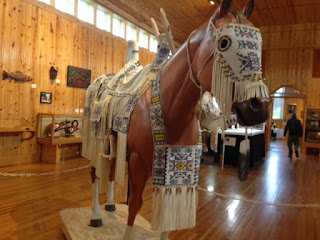 |
| Beads on display at the Indian Museum of North America, Crazy Horse Memorial, S.D. |
I spent much of the 1970's sitting cross-legged on my bedroom floor stringing beads while listening to Joni Mitchell. So, walking into the beads on display at the Indian Museum of North America on the campus of the Crazy Horse Memorial was heaven to me. All the tiny, sparkling objects! I've always been curious how the European import made it's way into Native American culture.
Where did these beads come from? How are they made?
The beads start off as a long, very thin tube of glass, which is then cut into individual segments. The Venetians were the undisputed king of the beads in Europe. As you can imagine, the task of transform molten glass into uniform beads takes a lot of practice and expertise. The Venetians were so protective of their methods that the secret was guarded by having all bead production isolated on the island of Murano.
The beads start off as a long, very thin tube of glass, which is then cut into individual segments. The Venetians were the undisputed king of the beads in Europe. As you can imagine, the task of transform molten glass into uniform beads takes a lot of practice and expertise. The Venetians were so protective of their methods that the secret was guarded by having all bead production isolated on the island of Murano.
The beads were used as items of trade in such places as Africa. By the 18th c 44,000 Venetian beads were exported around the world. After the fall of Napoleon, the Venetians lost their place as top producer. Other countries began making beads, notably Czechoslovakia. Czech glass beads reign supreme today. So, how did the European glass bead and the American Indians become a match made in heaven?
 |
| Even the horses get the bead treatment |
The lifestyle of the Indians was such that they had to pick up and move quickly. Whether chasing game or evading soldiers, the tribe couldn't afford to carry much with them that wasn't a functional object. Combining artwork with everyday items allowed them to express themselves. Many mundane objects were covered in bead work.
 |
| Bead decorated stirrup |
The bead work was most often created on looms or appliqued as embroidery. In fact, single-needle weaving, or peyote beading, and loom beading are Indian inventions.
 |
| Child's vest |
Different tribes had prescribed patterns and color preferences, but a woman could come up with her own design if she saw it in a dream.
 |
| The variety of patterns and colors are seen on this collection of moccasins. |
The artistry of the Native American bead work reached its peak after the Indian Wars came to an end. Settled into Reservation life the Indian bead workers were brought into regular contact with whites and other tribes. Though some beaded items were considered tribal property, there was now more freedom to experiment with design. Bead work became more complex in design and was used to cover everything from pipes to bags. Items were made not only for the tribe but for the tourist trade.



2 comments:
Wow Patti, I always wondered how those tiny glass beads were made. I own 2 tiny beaded horses I bought in NM--adore them. Always wanted to own a pair of beaded moccasins but I think the prices now are pretty prohibitive. Thanks for sharing this info!
Hi, Andi! Those tiny beads...I can't imagine the process of making them. And when I look at some of these pieces,I wonder how many hours and beads involved! I'd love to see your horses one day. I do like beading and wish I had time to pick it up again. Thanks for stopping by.
Post a Comment